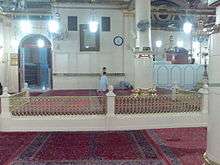Suffah

A Suffah is a room that is covered with palm branches from date trees, which was established next to Al-Masjid al-Nabawi by Islamic prophet Muhammad during the Medina period.[1]
Homeless and unmarried people, who did not have any relatives in Medina, dwelt in a Suffah where they were allowed to engage in art, agriculture, and other kinds of "business". These people were members of "Ahab al-Suffah", which translates to "Suffa Fraternity." Due to the scarcity of jobs caused by a combination of trade boycott and military threat,[2] members of Ashab al-Suffa had little income. It is estimated that a Suffah held up to 300 people at a time.[3] The Suffah was originally situated in the north of the Mosque from the right side of the Kaaba. When the direction changed towards Mecca in South, the Suffah was left at the rear of the Mosque, where it remained.
The most prominent member of Ashab al-Suffa was Abu Hurairah, as evidenced by Hadith. Members studied Sharia or Quran from Muhammad or from someone directly assigned by him. During wartime, those who were capable joined the army.
See also
References
- ↑ Richard A. Gabriel (22 October 2014). Muhammad: Islam’s First Great General. University of Oklahoma Press. pp. 25–. ISBN 978-0-8061-8250-6.
- ↑ "Ahl Al Suffah". Islamic Encyclopedia.
- ↑ "Ashab us-Suffah platform". Islamic Landmarks. Retrieved 2016-03-11.